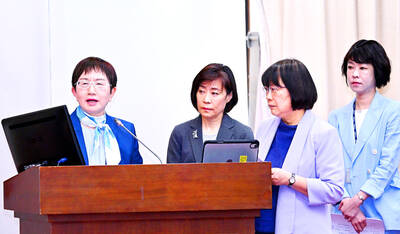The unemployment rate fell last month to its lowest level in nearly five years, an indication that the labor market in Taiwan is stable, the Directorate-General of Budget, Accounting and Statistics (DGBAS) said yesterday.
The jobless rate last month dropped to 4.07 percent from 4.17 percent in March, marking the lowest level since July 2008.
On an annual basis, unemployment fell 0.03 percentage points last month, the DGBAS said in its monthly report.
ACCURATE
However, the seasonally adjusted unemployment rate — a more accurate indicator of the long-term trend — rose for the second consecutive month to 4.19 percent last month from 4.18 percent in March, the DGBAS said.
“The labor market did not show deterioration, but also showed no significant signs of a rebound,” DGBAS deputy director Chen Min (陳憫) told a press conference.
The number of unemployed people decreased by 11,000 to 464,000 last month from a month earlier, with the number of people quitting their jobs due to dissatisfaction down by 5,000, and the number of people losing their jobs as a result of businesses downsizing or factories closing declining by 2,000, the report said.
However, the sluggish trend in export orders signified limited future demand for new employees in the manufacturing sector, Chen said.
Daniel Lee (李大華), a public relations director at manpower agency 1111 Job Bank (1111人力銀行), said the nation’s jobless rate may start rising this month since a large number of first-time jobseekers — who are about to graduate from the education system — are set to enter the job market and raise the seasonal number of unemployed.
The unemployment rate for those aged 20 to 24 stood at 13.04 percent last month, declining by 0.31 percentage points from March, with the rate for 25 to 29-year-olds down 0.31 percentage points from a month ago to 6.87 percent.
The DGBAS yesterday also published the average monthly wage of employees in the industrial and service sectors, which rose 0.74 percent in the first quarter to NT$37,508 from a year ago — the highest level ever recorded.
WAGE DECREASE
However, overall average monthly wages, including bonuses and compensation, dropped 1.64 percent to NT$54,897 in the first three months from a year earlier, as employers distributed fewer bonuses following weak economic sentiment last year, the DGBAS said.
After adjusting for inflation — which climbed 1.81 percent year-on-year in the first three months of the year — real average wages including bonuses and compensation fell 3.39 percent from a year earlier to NT$53,689 in the first quarter to hit the lowest level in four years, agency statistics showed.
The figure was lower than the NT$56,949 real average wage recorded in 1998, indicating that the nation’s wage earners are experiencing a tougher economy now than they did 15 years ago.

TECH CLUSTER: The US company’s new office is in the Shalun Smart Green Energy Science City, a new AI industry base and cybersecurity hub in southern Taiwan US chip designer Advanced Micro Devices Inc (AMD) yesterday launched an office in Tainan’s Gueiren District (歸仁), marking a significant milestone in the development of southern Taiwan’s artificial intelligence (AI) industry, the Tainan City Government said in a statement. AMD Taiwan general manager Vincent Chern (陳民皓) presided over the opening ceremony for the company’s new office at the Shalun Smart Green Energy Science City (沙崙智慧綠能科學城), a new AI industry base and cybersecurity hub in southern Taiwan. Facilities in the new office include an information processing center, and a research and development (R&D) center, the Tainan Economic Development Bureau said. The Ministry

ADVERSARIES: The new list includes 11 entities in China and one in Taiwan, which is a local branch of Chinese cloud computing firm Inspur Group The US added dozens of entities to a trade blacklist on Tuesday, the US Department of Commerce said, in part to disrupt Beijing’s artificial intelligence (AI) and advanced computing capabilities. The action affects 80 entities from countries including China, the United Arab Emirates and Iran, with the commerce department citing their “activities contrary to US national security and foreign policy.” Those added to the “entity list” are restricted from obtaining US items and technologies without government authorization. “We will not allow adversaries to exploit American technology to bolster their own militaries and threaten American lives,” US Secretary of Commerce Howard Lutnick said. The entities

Minister of Finance Chuang Tsui-yun (莊翠雲) yesterday told lawmakers that she “would not speculate,” but a “response plan” has been prepared in case Taiwan is targeted by US President Donald Trump’s reciprocal tariffs, which are to be announced on Wednesday next week. The Trump administration, including US Secretary of the Treasury Scott Bessent, has said that much of the proposed reciprocal tariffs would focus on the 15 countries that have the highest trade surpluses with the US. Bessent has referred to those countries as the “dirty 15,” but has not named them. Last year, Taiwan’s US$73.9 billion trade surplus with the US

The Taipei International Cycle Show (Taipei Cycle) yesterday opened at the Taipei Nangang Exhibition Center, with the event’s organizer expecting a steady recovery in the industry this year following a tough last year. This year, 980 companies from 35 countries are participating in the annual bicycle trade show, showcasing technological breakthroughs and market development trends of the bicycle industry at 3,600 booths, the Taiwan External Trade Development Council (TAITRA, 外貿協會) said in a statement. Under the theme “Ride the Revolution,” the exhibition has attracted more than 3,500 international buyers from 80 countries to preregister for the four-day event, which is expected to